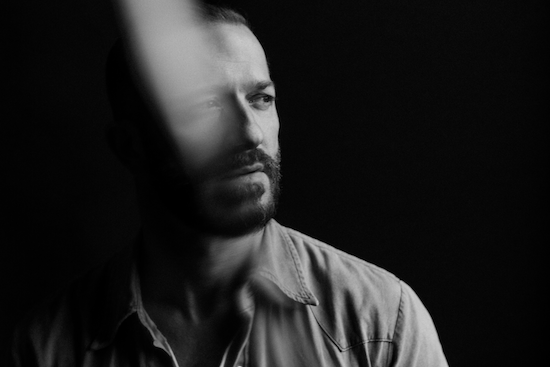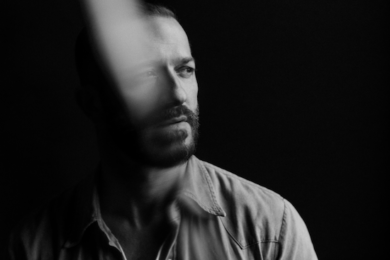Colin Stetson, portrait by Ebru Yildiz
Colin Stetson’s new single ‘When We Were That What Wept For The Sea’ begins with the quiet sound of human breath. It’s a simple but effective touch. Humans take 22,000 breaths a day, or thereabouts. The pressure of the thoracic pump, lifted by the diaphragm and intercostal muscles when breath is drawn, eventually helps oxygenate and clean an Olympic swimming pool’s worth of blood over the course of a year. Of all the wonderful things the body does, breathing – as an automatic, unconscious and life-sustaining function – is perhaps the least well considered.
Certainly, the unconscious aspect of breathing allows many to coast, given that most of us utilise just 10 percent of the actual full range of the diaphragm and a mere patch of the available inner lung surface when inhaling. People who work on strengthening their diaphragms and expanding their lung capacity, to the extent that their bodies literally change inside and out, are few and far between but they tend to cluster around certain jobs and pastimes. Committed freedivers, for example, can boost their lung capacity by up to 40%. Multiple world record holder and reigning “Deepest Man On Earth”, Herbert Nitsch, who has dived to a depth of 831 feet has twice the lung capacity of the average person. The average person looks physically different to Herbert Nitsch. With Colin Stetson, however, after 35 years of near constant horn practice and performance, the difference is less well pronounced.
Stetson is a musician who is often praised for his technical mastery of the bass saxophone, an unwieldy and borderline anachronistic instrument, once a staple of large American marching bands. His name has become shorthand for a certain type of muscularity and adrenalized exceptionalism when it comes to minimalist composition, arpeggiated soundtrack work and durational drone music. The gentleness of the breath here acts as a reminder that there is, actually, more to it than that. Some beauty, some gaiety, some tenderness even, some melancholy certainly; it’s the complexity of existence off the stage, away from the rehearsal space, outside of the studio. The instrument which in his hands had come to represent a celebration of power, has been repurposed to become a celebration of life.
The fascination of ‘When We Were That What Wept For The Sea’, released next Friday, lies in its dynamic agility. Interlocking arpeggiated runs, effloresce over a simple bassline of triplets, ascending slowly on a reverberant choir of vocalisations.
Stetson is unusually concise, if typically precise, when it comes to explaining the inspiration behind the song and the album it is taken from: “It’s my intention to not really talk a whole lot about this record. My father passed away recently and I wrote this for him. I’m pretty regimented and have a slate of things that I’m working on at any given time and there is an order to which I work on them. This wasn’t something that was expected. Sometimes things happen in life that we don’t plan for. So I stopped everything and wrote this record.”
The double album of new material was written, recorded and produced in a relatively short amount of time. It stands in sharp sonic contrast to his last album, the richly burnished, pearlescent landscape of Chimaera I, with its two long sonically and spiritually heavy tracks recorded and assembled from a number of long single takes. (It is “the closest thing” to drone metal he will ever record and the first in a new series of self-released experimental albums, he says.) A number of pieces from Wept For The Sea, including the title track, are making up a significant proportion of the set list for his upcoming tour. As much as he understandably doesn’t want to speak too much in public about his father’s passing, he describes the record as having “a certain sadness to it, but also a kind of whimsy… it’s a little bit of a fairy tale. It’s a beautiful object that I’m very proud of.”
Talking of the upcoming tour he mentions that he will be unveiling a live visual effects system which he has been working on for several years. It is a way that all of the lights and film he uses are triggered by his music via microphones on stage: “The technology is now so good we can translate a lot of information from analogue audio into digital control.”
Given that Stetson’s peculiar live and studio set up – essentially a large number of microphones arranged on and in his instrument, on his body and in the performance space feeding into one mixing desk – allows him to fill multiple sonic roles such as ‘percussionist’, ‘bassist’, ‘lead’ and ‘vocal’ simultaneously, this means he’s essentially a one man band. I ask if he has particular trouble in ceding control to other people.
He laughs long and hard: “Yeah, if I could control the temperature and smell of the venue [by playing the saxophone], I totally would.” Before adding simply that because he likes the visuals to hit certain beats during certain styles of playing, the only way for this to happen while he’s improvising is when it is intelligently automated by the music itself. He concludes: “Some music is collaborative and some isn’t. And this music is not collaborative. All of it – its design, its nature – comes from me, so I try to produce every aspect of how it is presented.”
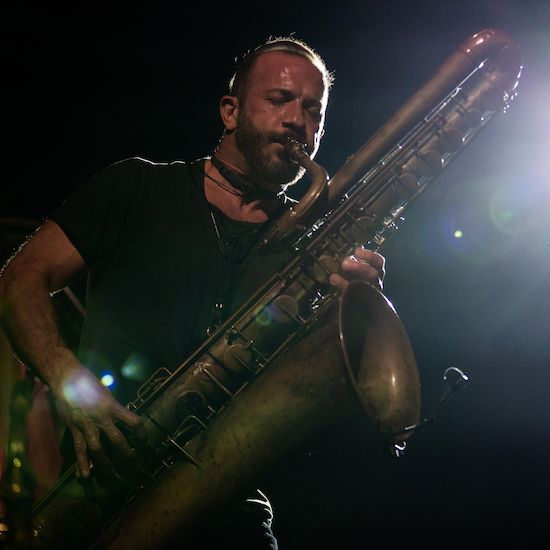
Colin Stetson live at the Union Chapel, London, by Jose Ramon Caamano
Colin Stetson didn’t grow up in a particularly musical household, although both of his parents had “beautiful singing voices”. His Dad, who spent his working life as an MD and PhD cancer researcher, was a singer in a rock covers band when younger, and one thing he passed down to his son was a deep love for Hendrix. His Mum had always wanted a piano but her father, from a very poor Italian immigrant family, had himself grown up in a “jack shit” rural existence and considered it a pipe dream. He pinpoints this and his parents’ relative affluence compared to the previous generation as reasons they were keen to support and fuel his musical ambitions from a young age.
Born in 1975 in Ann Arbor, Michigan, he says he was part of the first generation “raised by MTV” and received the first stage of his early musical education courtesy of Prince and – importantly – Australian new wave band Men At Work, who were the first to make him fixate on the possibilities of the saxophone when he was five: “I saw the video for ‘Who Can It Be Now?’ by Men At Work. This was the 80s so there was a saxophone on everything. It’s an instrument that’s been in popular music since the 30s but the 80s was definitely the heyday, and the memory of this song in particular is burned into my brain.”
Speaking from his home in Quebec he laughs as he recalls becoming obsessed with the instrument just as it fell completely out of fashion: “The 90s was a weird decade to become a saxophonist. There was a reaction against the instrument due to the excesses of the 80s. It’s best represented by Tim Cappello’s appearance in The Lost Boys. He was Tina Turner’s sax player and he is just so, so, awesome but in this film you see him as this totally ripped, topless, fully-oiled dude in a ponytail holding a tenor sax in his brute hands and just screaming through it. However: do you want to know why grunge happened and why the sax fell out of style? That’s exactly why.”
But Stetson had little interest in how popular the instrument was. After some private lessons at the age of 15 at the nearby Michigan University with talented reedsmen Christopher Creviston and Donald Sinta instigated a quantum jump forward in his learning, he was hooked in for life. These lessons saw the self-described “mediocre” teenager become groomed for a scholarship at the university where he would also study with the legendary co-founder of the Art Ensemble Of Chicago, Roscoe Mitchell. Having been thrown in at the deep end he arranged his life so he could spend ten hours a day practising: “I was put into a sax quartet of all graduate students and seniors, the top bands; I was playing symphony music, playing in ensembles. There was a lot of pressure and responsibility from the get go. I felt like I was competing with killers who’d been there for years.
“I didn’t enjoy living with other people in a cramped apartment, so I structured my life around being out as much as possible. I’d sleep in the early morning, go to class, come back, have a nap, then just go out again and practise all night. I befriended the janitor [of the rehearsal rooms], so he didn’t mind. My practising took place when no one else was around. Zero distractions. It acted as a strong technical foundation for the rest of my life.”
Little by little he started heading towards developing unique variations on various advanced techniques. He picked up circular breathing quickly: “My school teacher showed me this technique, where I had to put tissue paper up against a wall, and then keep it up there by blowing. The mechanics are, you keep air in your mouth and blow out while you try and get a sip of air in. It’s like riding a bike, in that it’s a trick of coordination. It’s about your lung capacity and the musculature in your face, and the capacity for air in your neck and in your mouth. At first I could do it for 30 seconds. How long can I do it now? I’ve no idea, it’s not how I think about it. But I can do it for a long time, it’s just I’m not interested in only playing one note forever.
“That was where it started, in school. But by the time I was 18, I was listening to a lot of Squarepusher and Autechre and Nobukazu Takemura, and I was starting to think, ‘How does one emulate electronic music with a horn?’”
Simultaneously, he was also learning vocalising (“I’d heard Dewey Redman and Mats Gustafsson doing it beautifully”) and voicing (“It’s manipulating your body’s acoustic cavities. In effect you’re playing the instrument with your throat and not your fingers.”) And this in turn opened up the door to multiphonics: essentially playing high and low parts on the horn, at the same time. It was while practising his new style one day at the university, one of his tutors burst in saying, “What are you doing, and how are you doing it?” After Stetson explained, the teacher promptly cancelled the day’s lesson so he could go away and catch up with his student: “It just became this bright spot in my memory. I was like, ‘Ok, this is significant. Hang onto this and keep on going in this direction as far as you can.’”
As much as the sax had fallen out of mainstream favour Stetson was having his head zapped off campus by such underground groups as Mr Bungle and John Zorn’s Masada, as well as by key records in the back catalogues of Ornette Coleman and John Cotrane: “Zorn was big when I was younger. The saxophonist I latched onto sound-wise was Thomas Chapin, an amazing player from New York who died tragically early from leukaemia just before his 41st birthday. He was and still is a big influence on me.”
One record in particular played a key role. The 1987 free jazz LP Low Life by Peter Brötzmann and Bill Laswell introduced him to the sublime joys of the bass saxophone, an out of favour, difficult to play, marching band instrument that Stetson has since essentially made his own: “I always had an affinity for the lower end of things and I liked the physically intimidating and challenging nature of the instrument. It was mano-a-mano, the physical representation of the object versus your body. It was more symmetrical in terms of the instrument’s stature and weight. I liked the freedom of exploration acoustically it gives you with the deeper, longer and wider tube. It gives you much more of a breadth and depth of frequency to play with. After I heard Low Life the instrument became a lifelong obsession. I think there’s something singularly beautiful, aggressive and hypnotic about the sound it makes.”
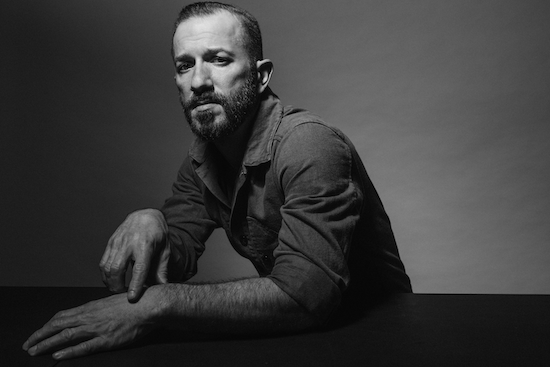
Colin Stetson, portrait by Ebru Yildiz
Adolphe Sax, a Belgian born in 1814, was extremely lucky to survive childhood. When he was a tot, he fell headfirst from a three storey building onto stone, knocking himself out, his family, not unreasonably, believed he was dead for sure; when he was three he drank a bowl of acid believing it to be milk and not content with that he later swallowed a pin; he received serious burns in an unspecified gunpowder accident; he also once fell into a frying pan, receiving, yet again, serious burns; on several occasions he avoided asphyxiation and poisoning from sleeping in a room where highly toxic varnish was drying; while still a child he was struck on the head by a cobblestone and fell into a river where he nearly drowned. Locally he had the nickname ‘Little Sax the ghost” and his mother said, “He won’t live.” But live he did and he grew up to be an instrument maker. During a particularly purple patch in the early 1940s he invented the saxophone and nine different variations on it, including the bass saxophone.
Stetson explains the early attraction of the instrument: “It was marketed as an instrument to replace low brass, because it could have the same kind of power and depth on the bottom while having much much more agility and better definition. It came to be used a lot in military bands. It made the switch over to the early swing period in New Orleans and Chicago jazz, but its popularity really dissolved after that. During the 50s and 60s the popularity it once had just bottomed out. You had upright basses doing the same job because amplification had changed everything.
“It is hard to play. It takes an enormous amount of wind. It sucks to handle in practical terms because it’s enormous. They get easily damaged because there are a lot of moving parts.”
He sighs and points over his shoulder: “I have one right here. If any one of these springs and rods [he gestures up and down the length of the instrument] gets even slightly bent or displaced, then the whole thing stops functioning. For the most part people shy away from things that are physically more demanding. It’s much easier and more rewarding to play the electric guitar. But, like I said, I’ve always been attracted to that instrument specifically because of those qualities, and so it was just kind of perfect for me.”
He looks back at the instrument lurking behind him again: “They did not have people in mind when they built them. It was a case of, ‘Just get used to it, asshole.’”
During college he became a virtuoso saxophonist who also played the bass clarinet, French horn, flute and cornet, and after graduating he joined the Transmission Trio before becoming a sideman of some standing, recording and playing live with the likes of Tom Waits, Arcade Fire, Lou Reed and LCD Soundsystem. But it was via a series of groundbreaking solo albums that he really began to make an impact on the international musical landscape.
On New History Warfare Vol. 1 (2008) he finally got to showcase all of these techniques, a dazzling palette of sonic possibilities. In applying reinvigorated techniques usually associated with free jazz to minimalist composition played on a bass sax; in taking influence from a wide range of music that included extreme metal, contemporary classical and the IDM sounds coming out of England (Aphex Twin, Autechre and Squarepusher); and in blasting away at the boundaries imposed on the recording of solo saxophone, he created an inimitable style all of his own: “The whole idea has been trying to create a multiplicity out of a singularity; to take a single instrument, a single player, and trying to split that into a multiplicity of musical roles.”
The use of multiple contact mics placed all over his instrument, his body and the walls of the room he was playing in allowed him to manipulate multiple feeds from a single solo performance in order to create densely textured tracks that ran from dubbed out percussive rhythm compositions to elegiac celestial laments via sub bass heavy analogues for minimal techno and glistening edifices of arpeggiated modern minimalism.
He explains how his approach to amplification and recording developed: “By this point I was opening up for rock bands and I realised that nobody could hear any of this shit that I was doing. But if you have just one microphone in front of a horn you’re really not getting the full picture. So I put a microphone in the bell and I put a microphone on the outside of the instrument, to get the fundamental [note] and to get the air. But then I didn’t want the percussive aspect to get lost, so I started putting microphones on the instrument itself and then on the keys themselves. And then on my throat to pick up the vocalising, and then around the room…”
If anything his work ethic has intensified over the last dozen years. New History Warfare Vol. 2: Judges was shortlisted for Canada’s Polaris Music Prize in 2011 and the album was an unexpected critical and commercial hit, being declared an album of the year by this site. As well as the third album in that series, released in 2013, he recorded a joint album with his then partner Arcade Fire’s Sarah Neufeld, Never Were The Way She Was in 2015: “To me, this was an exploration of the origin story of a character involved in the narrative of the New History Warfare albums. I wanted the idea of the narrative of something that comes before to be reflected in the music so I drew heavily from two formative things from my past: metal and electronica from the 90s.”
A growing reconnection with metal also informed another project, the self-explanatory SORROW: A Reimagining of Gorecki’s 3rd Symphony, in which he completely overhauled his sound to produce an overpowering, maximal experience enhanced by the influence of progressive black metal as well as IDM. He says: “I heard it for the first time in 1994 and by 1998 I was talking with friends about the idea of us doing it. My sister is an opera singer and I was wondering, ‘Can we actually do this and you can sing?’ It was on the backburner for years before a festival asked me in 2015 if I could do something Gorecki-related and I’d just met the drummer Greg Fox whose work in Liturgy was transformative for me. I’d been more an appreciator of black metal rather than a fan up to that point, but there was something about Aesthethica which was groundbreaking, not just for metal but for music generally. It was representative of something I’d been looking for in my solo work.
“Once we talked about it, it coalesced almost overnight. We were trying to explore maximalism. I know it’s a misuse of the term but it’s the way we described the music, as being maximal; imbuing both time and space with as much content rhythmically and harmonically as possible while still retaining a minimalist structure of progression, melody and form.”
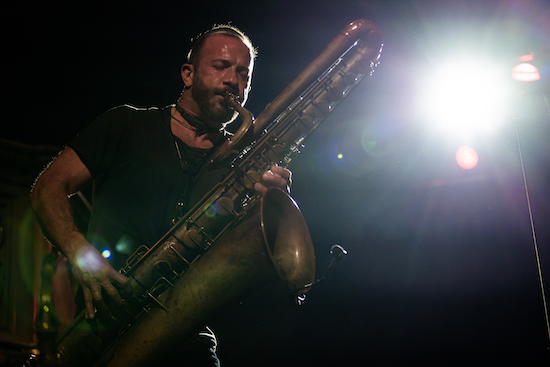
Colin Stetson live at the Union Chapel, London, by Jose Ramon Caamano
So many of his recordings had been repurposed as soundtrack music over the years that it was perhaps inevitable he would become a film composer in his own right. After work on Jacques Audiard’s Rust And Bone (2012) and Steve McQueen’s 12 Years A Slave (2013), he was commissioned to work on his first full-length feature, Alexandre Moors’ Blue Caprice (aka The Washington Snipers) in 2013, another collaboration with Sarah Neufeld. Other original soundtracks followed but one of the high watermarks of his career to date is his harrowing and triumphant work on Ari Aster’s Hereditary (2018).
Aster’s complete trust in Stetson has since paid dividends. Along with work made by a new wave of soundtrack composers such as Mica Levy, Gazelle Twin, Geoff Barrow, Clint Mansell, Hildur Guðnadóttir, Mark Jenkyn, Cavern Of Anti-Matter, Nick Cave & Warren Ellis, Trent Reznor and Atticus Ross, the Haxan Cloak and Robert Aubrey Aiki Lowe, the effectiveness of his scores means that small to medium independent studios are becoming much more likely to take a chance on non-standard scoring.
Aster talked to Stetson about the film years before it went into production and, importantly, didn’t use already existing music as a temp track guide for him: “He gave me the script, a list of locations and photographs of the characters and that was it. I wrote the score to be a fifth character in the family: the character of the house. I asked him, ‘Is there something that the audience is supposed to be guessing? Are we trying to trick them?’ And he said, ‘No, no no. The house is evil. That’s what it is.’ And that was hugely liberating. I like strong definitions and creative confinement. All of my solo work has very strict parameters, so I like that in scoring as well.”
He wrote songs in advance so they could be given to the actors to absorb. Alex Wolf, who plays the luckless son Peter Graham, listened to his tracks incessantly before shoots to get himself in the right frame of mind. His experience of making the film in general was so intense, it has been claimed that he ended up with PTSD. My own experience of watching the film on a whim as a birthday treat to myself on its day of release, not knowing a single thing about it, was thankfully entirely different. It provoked one of the heaviest sensory stimuli-induced psychedelic experiences I’ve ever had, to the extent it was a directly comparable analog of coming up on LSD. The realisation that the whole film – including the score – had been leading up to its unhinged denouement accompanied by the magisterial fanfare of Stetson’s ‘Reborn’ was delicious and gifted me a dizzying spell of genuine, hard-edged transcendence.
He explains: “The whole soundtrack is a reconstruction of the ‘Reborn’ song that comes at the end. If you go back and look for breadcrumbs after the fact, they’re all kind of laid out but they’re flipped into a major [scale] triumphant mode at the end. During the film it’s sinister because you’re outside looking in, but at the end you’re inside looking out. It’s victory.”
After Wept For The Sea, Stetson’s music will be next heard gracing the long delayed Uzumaki anime for Adult Swim, based on the work of Japanese Manga master, Junji Ito. For those who haven’t had the pleasure/horror, Ito’s original series of strips from 25 years ago, describe the loosely connected trials and tribulations befalling the citizens of Kurouzu-cho, a Japanese fishing village, plagued by a weird metaphysical curse governed by spirals. Above and beyond the obvious idea of the spiral being related to the hypnotic arpeggiation and organic looping of his music, there is also the way that Ito focuses in on an idea and takes it way beyond its logical conclusion, exploring every single avenue he can imagine. An idea that I would say is core to Stetson’s practice as well.
He says: “Yes! It was one of those moments where I was like, ‘That’s my job!’ I love that manga so much, not just because it’s excessively violent, gory and disturbing, but because it’s also really gorgeous, haunting and seductive. The theme song I wrote is one of the things I’m proudest of. I love it. It feels like what I think it might feel like to be an animal that gets caught in headlights… ‘Uh! Uh!’”
He starts laughing, before concluding: “There’s a shudder of information in Uzumaki. There’s so much of that in the book, especially at the end when you’re in the depths of it, and you’re reading it going, ‘Wait a second… what?!’ But everything is a swirl and there’s an immensity to it. It’s brain bursting. It overloads you but at the same time it’s very beautiful. It’s awful and death abounds but also it’s quite lovely. And those are the two needles I’m trying to thread.”
Colin Stetson plays Brighton Attenborough Centre For The Creative Arts on 29 April. His label 52Hz and will release When We Were That What Wept For The Sea single on 7 April and album on 12 May

